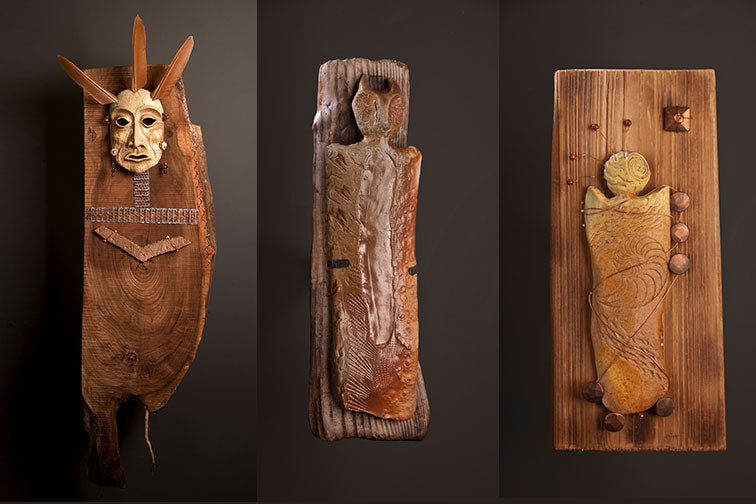The Art of Lillian Pitt

Lillian Pitt, Distinguished Big River Artist, in Person Show in Sisters,
June 22-24; Artists Reception Friday, June 22, 4-7 pm
For 15,000 years ‘the big river’ to the North—Wimhal, Nch-i-Wana, Swah’net’qhu or Columbia—has sustained, supported, and inspired human societies. Distinguished Oregon artist Lillian Pitt, raised on the Warm Springs Reservation of which she is a tribal member, first and foremost considers herself a Big River person.
“My ancestors were traders and innovators. They traded goods and exchanged ideas with people from many Native traditions. I honor my ancestors by carrying on this tradition of exchanging goods and ideas through my art.”
Long before she became a distinguished artist, Lillian owned and operated a successful hair styling business. But eventually, as many people who have artistic inclinations will do, Lillian took a class. She remembers one aspect of it quite clearly, “Once my hand touched the clay … I knew!” This calling mixed with her sense of heritage, and that combination gradually but steadily developed. In time, it became a force of nature within the art world of the Pacific Northwest.
The Portland Art Museum offers the finest collection of Native American Art in Oregon and represents one of the best collections in the United States. These works span both the North American continent and its history, from ancient times to the current era. The works of Lillian Pitt are displayed prominently at the entrance to the expansive collection.
The Museum at Warm Springs has held exhibitions honoring Lillian’s work and displays her pieces at the entrance to the Collections Room. The High Desert Museum also exhibits her work. The Smithsonian’s Museum of the American Indian in Washington D.C. and The Burke Museum in Seattle, hold yet another nationally respected collection. The list of awards, shows, and exhibitions for Lillian’s career is over three pages long. Books have been written that include her works; books have been written about her works. Her place as the preeminent living Native American artist of Oregon is unquestionable.
These distinctions however, may place a certain kind of artistic perimeter around Lillian, creating a perception that her Native American roots and artistic traditions are what enabled her to be so successful. While she does not shy away from those connections, a single opportunity to see Lillian’s pieces at a show, one chance to meet her, quickly broadens the perspective a person might hold regarding her ability as an artist.
Lillian has come to understand, incorporate, and master many of the concepts and techniques of contemporary Western art. Her range of mediums—glass, clay, metal, jewelry, printmaking, multi-media—establishes an exceptional breadth of skills for any artist. In short, her dynamic artistic abilities demonstrate that she would have been a highly successful artist had she chosen Western World subjects and motifs. Her Honorary Doctorate from the University of Portland nine years ago exemplifies this high regard for her and her abilities.
“Everything I do, regardless of the medium, is directly related to honoring my ancestors and giving voice to the people, the environment, and the animals. It’s all about maintaining a link with tradition and about honoring the many contributions my ancestors have made to this world.”
Lillian has travelled far beyond the region of the Big River to New Zealand, Fiji, The Marshall Islands, and Japan. This came about for sharing, learning, and experiencing the tradition and art of their First Peoples. What she came to understand in these far off ‘worlds,’ more than anything else, was the sense of shared connections regarding ancestral roots. Subsequently, these travels served to deepen her own sense of place and belonging to the The Big River of the Pacific Northwest.
Lillian remained true to her ancestral heritage throughout her early and middle art career. Her identity as an artist of her people has helped to raise the public’s awareness about the First Peoples of this region, allowing for a beautiful and contemporary perspective. In the 70's and 80's, the art world was embracing a number of modernist movements that fairly excluded tradition. Art was trendier then; elegant and enduring could be brushed aside as being passe´. Lillian did not waiver; she stayed with what had shaped her. In short, she chose the most honorable yet more rigorous path. Now in her 70’s, she still walks it.
Lillian will be holding a show in Sisters June 22 – 24 with an Artist Reception on Friday from 4 to 7 pm. Her new works will be on display at Raven Makes Gallery.